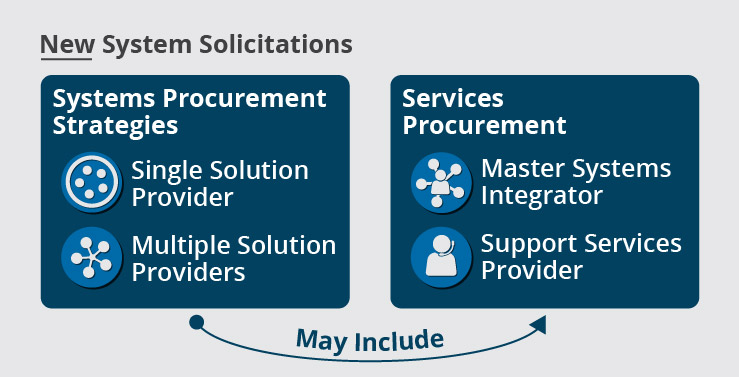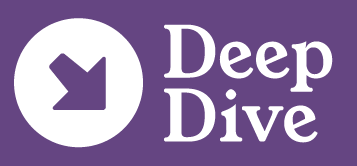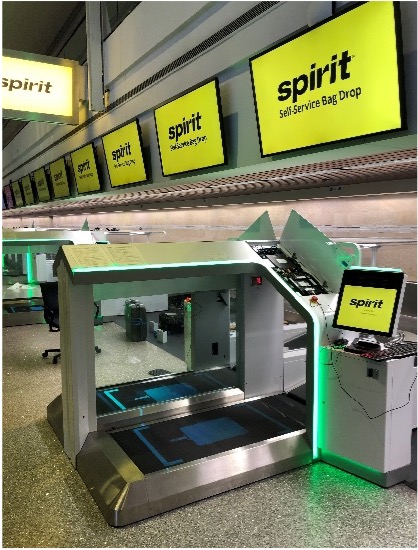


This page includes all content for this chapter.
Chapter 8: Procure Common Use Solutions
There are many variables to consider when procuring common use solutions, including the type of solicitation being used and the strategy for solution providers. Based on these variables, there are key solicitation requirements that should be included and essential evaluation criteria that should be considered, as shown in Figure 8.1.

Figure 8.1 Solicitation Variables, Requirements, and Criteria
The following sections describe each of these variables, key requirements, and essential criteria.
Solicitation Type
Common use solutions are generally procured as a system implementation (either new or replacement) or during a facility construction project (such as a new terminal).
System Implementation
When common use solutions are being procured directly as a system implementation project, the airport operator has complete control over the requirements. As described in Chapter 7, it is important to identify the right requirements, such as those that align with the business need for maximum integration with other systems in support of the holistic common use program. An airport operator may have this expertise in-house or may look to a consultant for advice.
Facility Construction
In a design-bid-build construction project, the airport operator has the same influence on the requirements for the technology systems as they would in a system implementation project. However, when a construction project is following an at-risk delivery method, the airport operator will have limited influence on requirements. In this method, the construction manager must deliver the project at a guaranteed maximum price and is responsible for selecting the required solutions. Since the airport operator will have limited influence, the following guidance on solicitation strategies, key requirements, and essential evaluation criteria may not be applicable.
Solicitation Strategy
There are a few strategies to consider depending on the existing systems and business needs of an airport. These are summarized in Figure 8.2.

Figure 8.2: New System Solicitation Strategies
There are two basic strategies for procuring new systems: using a single solution provider for all components or using multiple solution providers for different components (or “best of breed”). Further, as shown above, either strategy may include master systems integrator or support services as part of the solicitation; however, some choose to procure these services separately.
Another option that some may consider is to procure a new services provider for existing systems, as shown in Figure 8.3.

Figure 8.3: Services Solicitations for Existing Systems
The following sections provide further detail for each of these solicitation strategies.
Single Solution Provider
A frequently used common use solution solicitation strategy has traditionally been the selection of a single solutions provider to provide solutions such as common use passenger processing systems, common use self-service, flight information display systems, and airport operational databases and resource management systems. This approach is the simplest procurement for a standard common use offering because it only involves a contract with one firm, and the proposed solution does not generally have a high level of integration risk. The individual components may be from different solution providers, but the contracted firm is typically a solution provider with a proven integrated solution.
Multiple Solution Providers
An increasingly used solicitation strategy is to select multiple solution providers for different systems based on which best meets the airport's specific needs. This is referred to as a best-of-breed strategy. Oftentimes, this does not happen in a single solicitation, or even at the same point in time, but rather at a contract renewal point when one system component may be renewed but another component replaced. When multiple solutions are procured at one time in this manner, it can be accomplished through a single solicitation that permits solution providers to propose on one or more scope elements. It can also be done through the issuance of separate solicitations for each scope element.
This strategy is complex, and the solicitations must include requirements for how the separate providers work together and how the systems will integrate with one another. If responsibilities are not thoroughly and clearly defined, this approach has the potential to result in a lack of accountability when problems arise.
Master Systems Integrator
A master systems integrator (MSI) is a role specifically designated to address the integration requirements between disparate systems. It is the responsibility of the MSI to drive the system integration strategy and implementation throughout the project lifecycle. They work on behalf of the stakeholders to ensure the successful integration of all systems. In a large construction project, the MSI would be engaged in the program definition, requirements development, design, procurement, construction administration, testing and commissioning, and operational readiness, activation, and transition phases. The MSI helps to mitigate risk, reduce unplanned costs, improve testing across all systems and platforms, minimize schedule impacts, and achieve day 1 operational readiness.
Naturally, the MSI role is most applicable to the multiple solution providers strategy. In this case, the MSI role may be awarded to one of the selected solution providers, or it may be separate from the system solicitation itself. However, the MSI role may be applicable in a single solution provider strategy if the existing common use environment is already well-integrated with other systems. In this case, it may be advisable to include specific requirements for the solution provider to act as an MSI to ensure the new systems provide the same or better level of integration. These services could also be procured separately from the system solicitation itself.
Regarding existing systems, it may be that these systems are not well integrated with other systems in the environment. In this case, an MSI can be very beneficial to improving the integration.
Support Services Provider
Support services for traditional common use solutions are typically categorized under three levels:
- Level 3: Application support
- Level 2: System administration tasks
- Level 1: General technical support
Levels 3 and 2 are typically provided by the solution provider and Level 1 by either the solution provider or the airport operator through staff or contract support. In a holistic common use program, the support needs of all systems should be considered for the technical and process interdependencies that they have. While application support may need to reside with the system provider in most cases, the general technical support and system administration needs for all systems may be best provided by the airport operator through staff or contract support.
Key Requirements
There are several requirements that should be included in the solicitation that go beyond the system-specific functional, integration, and technical requirements addressed in Chapter 7. These requirements help to ensure that the solution chosen is the best fit for the airport.
Issues and Challenges
Chapter 3 addresses several issues and challenges by different stakeholder groups that need to be considered when selecting a solution. Consider the challenges that exist in your current environment that could be addressed in the common use solution. For example, consider asking solution providers how they address airline proprietary needs, such as ticketing, point-of-sale, service recovery, or adaptability for peripherals.
Implementation
Require that the solution provider submit a project management plan and a quality management plan.
Proof of Concept or Demonstration Testing
Consider requiring a proof of concept or demonstration testing phase to the solicitation process if the requested solution requires new or unproven capabilities or complex functionality.
Design
Require that the solution provider deliver a complete system design document that includes descriptions and drawings for design details of the system as a whole, individual systems, core system configuration (including servers, services, applications, and connectivity), hardware configuration, and an interface control document that defines each system's interface.
Testing
Require that the solution provider submit a master test plan that defines their approach to the entire testing program, including pre-delivery unit testing, factory acceptance testing, user acceptance testing, installed integration testing, and endurance testing.
Training
Require that the solution provider develop a detailed training program and provide course outlines, course materials, and syllabi prior to the scheduled training initiation date. Training should be conducted for end users (such as airlines), administrators (level 2 support), and system support (level 1 support) users as appropriate.
Acceptance Criteria
During turnover, require the solution provider to execute turnover of system requirements to the airport during the endurance testing phase that includes any final training and documentation such as asset management. During commissioning, require that the solution provider conduct final system acceptance and full commissioning of the system to the airport and airlines upon successful completion of the endurance test period.
Essential Evaluation Criteria
Evaluation criteria for a common use solution needs to measure the things that matter in a way that truly separates the competition and clearly identifies the best option. Specifically, evaluation criteria should be aligned with a holistic common use perspective and be adequately detailed.
Aligned with a Holistic Common Use Perspective
An airport operator with a holistic common use perspective should consider the following three questions:
- To what extent does this solution fit the airport's holistic common use roadmap?
- To what extent does this solution have the interoperability needed to share data and integrate processes with other systems within the airport's enterprise architecture?
- To what extent will this solution provider be a long-term business partner that will enable the airport to achieve its holistic common use program vision?
Adequately Detailed
Break criteria down into a level of detail that will be sufficient to allow evaluators to clearly determine which of the following categories each item belongs to:
- Exceeds expectations
- Meets expectations
- Minimally acceptable
- Non-compliant
Each of these categories should be weighted based on agreement by the selection panel, with “exceeds expectations” having 100% and each level lower having a progressively lower percentage, down to “non-compliant” receiving 0% and assessed as a potential factor for disqualification.
The total score available, after the solution price points are removed, should be allocated to the criteria down to the lowest level of granularity. After the weighting and point distribution have been established, the selection panel can make their judgment on the level of expectations achieved without consideration of the point values that will be attributed. This makes the rating process easier on the panel members and avoids any unintentional bias due to a perception of how the score may turn out.
While some evaluation criteria will be subjective (such as qualifications, design approach, and alignment with strategic objectives), the functional, integration, and technical requirements should be rated with objective scoring. They must be thoroughly evaluated by someone with the right level of expertise to identify the extent of compliance and the impact of any level of non-compliance.
Airport procurement departments have become quite experienced in dealing with technology-related solicitations, but experience alone does not always equate to desired outcomes. Understanding the different solicitation types and strategies will help you choose the approach that will work best in your case. Further, identifying the right solicitation requirements and evaluation criteria will play the biggest role in making the right selection.
Looking beyond the procurement and implementation of solutions, the next chapter addresses the needs for the day-to-day management of the holistic common use program.



